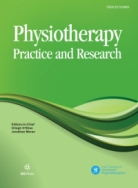Authors: Cook, Chad | Bragg, Malinda | Congeni, Joseph | Donaldson, Megan | Peiffer, Jeffrey
Article Type:
Research Article
Abstract:
Background: The purpose of the study is to measure the relationship of findings of the Goutallier classification, a qualitative measure of fat content within a designated muscle group, and a dichotomous measure of fatty infiltration (presence or not present) toward delayed or poor recovery after physiotherapy intervention. Methods: The retrospective predictive validity study involved 35 adolescent patients diagnosed with spondylolysis, who received magnetic resonance imaging (MRI) prior to physiotherapy care. Scoring of presence of fatty infiltration and Goutallier classifications from the MRI were compared to success or delayed or poor outcomes with physiotherapy, upon patient discharge from formal care. Results:
…Although agreement among the physicians who were responsible for scoring was poor, consensus findings of fatty infiltration on both measurement mechanisms were related to delayed or poor physiotherapy outcomes (correlation = 0.28, and the sensitivity of presence of fatty infiltration was 76.2% [95% CI = 61%, 87%], the specificity was 69% [95% CI 44%, 87%], the LR + was 2.5 [95% CI 1.1, 6.8], and the LR– was 0.3 [95% CI 0.1, 0.8] for delayed or poor outcome). Discussion: To our knowledge, this is the first study that has looked at whether fatty infiltration of the multifidus muscle in adolescents was associated with poor or delayed recovery in physiotherapy treatment. Conclusions: The results indirectly support the importance of the multifidus muscles in recovery of low back pain and suggest the significance of future, further research.
Show more
Keywords: Adolescent, fatty infiltration, low back pain, magnetic resonance imagery, multifidus muscles, outcomes
DOI: 10.3233/PPR-2012-0011
Citation: Physiotherapy Practice and Research,
vol. 34, no. 1, pp. 29-35, 2013
Price: EUR 27.50





